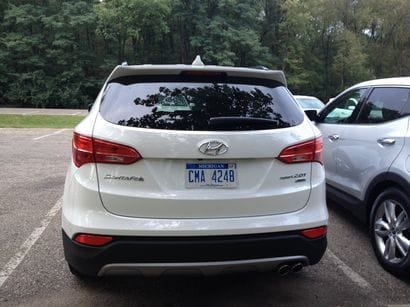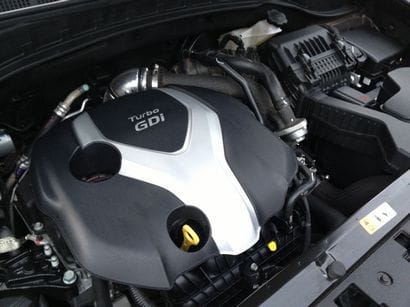We get the chance to drive the first of two new Santa Fe models
More room, more choices
For 2013, Hyundai has upped the ante in the crossover SUV segment by offering not just one but two flavors of its popular Santa Fe. The first, which replaces the current model, has been re-christened the Santa Fe Sport.
The second, minus the "Sport" suffix, will now adorn an extended wheelbase three-row version built off the same platform (and replacing the current Veracruz) and will commence production, we've been told, in December and reach Hyundai new car dealers sometime next January.
While the long-wheelbase Santa Fe currently exists only in pre-production form, we were given the opportunity yesterday to drive the Santa Fe Sport on some of the back roads that wend their way through a portion of Michigan's farming country between Novi and the State Capital of Lansing. Here are some of our impressions.
2013 Hyundai Santa Fe Sport
We'll begin with the changes.
To the 2012 Santa Fe Hyundai has added knee airbags, a strengthened roof, an underbody cover and additional sound dampening. Taken together these changes increased vehicle weight by 69 pounds.
Hyundai engineers were then assigned the task of actually bringing the Sport's weight in under that of its predecessor. The result: 213 pounds were shed through changes in chassis design, sheet metal width and the increased use of high tensile steel (37.7 percent in the 2013 Sport versus just 7.8 percent in the 2012 Santa Fe).
Another 62 pounds was dropped with a revised door garnish, wiring system changes and new seat frames. 50 more pounds were subtracted due to suspension, powertrain and other revisions resulting in a net weight reduction of 266 pounds.
Under the hood, buyers will have a choice to two engines – Hyundai's normally-aspirated 2.4-liter gasoline direct injection Theta II engine that produces 190 horsepower and 181 lb.-ft. of torque (up 15 horsepower and 12 lb.-ft.) or the company's 2.0-liter twin-scroll turbo Theta II engine with 264 horsepower and 269 lb.-ft. of torque (a drop in 12 horsepower over the former 3.5-liter V6, although the weight savings should result in better performance while improving fuel economy).

The only transmission choice is a smooth-shifting six-speed automatic.
The new Santa Fe Sport also takes a page from Hyundai's "Fluidic Sculpture" design language. Its lines are now crisp and modern looking. This was particularly evident when, driving back on the expressway, we passed what was probably a 2011 or 2012 Santa Fe and, for a moment, we thought it was a first-gen model – the styling changes have made that much of a difference.

Not only does the new Santa Fe Sport look slicker, it is. While the wheelbase remains unchanged and overall length is up by only a half inch, width is down by 0.4 inches and overall height is down by almost an inch and a half (1.4").
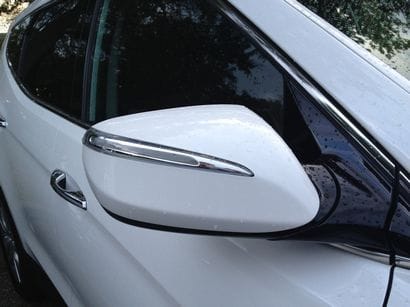
Combine these changes with an underbody tray and increased insulation and the result is a coefficient of drag that has been lowered from 0.38 to 0.34. These changes speak (and can be heard) for themselves with interior noise levels down significantly from the outgoing model.
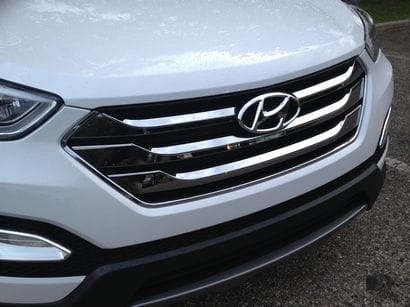
Additional styling niceties include what appears to be a new lighting trend: square-shaped projector beam headlamps. These are surrounded by LED headlight accents while a rear spoiler with LED brake lights is also standard.
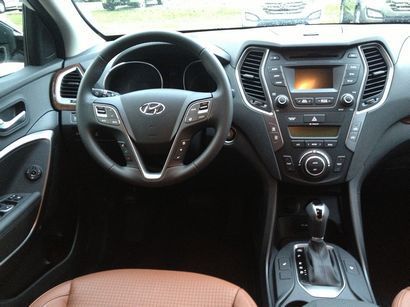
Interior
As with each new Hyundai we get a chance to evaluate, the new Santa Fe Sport's interior sports a modern and well-executed interior using world-class materials. Its twin-cockpit design is comprised of pleasing curves and soft-touch surfaces. The front seats offer plenty of support and all controls are logically placed within easy reach of the driver.

On the road
Other than a slightly numb feeling on-center, the electric steering does a decent job of communicating where you are on the road. It seems that Hyundai is getting better at this, although there is still some work to be done in that department.
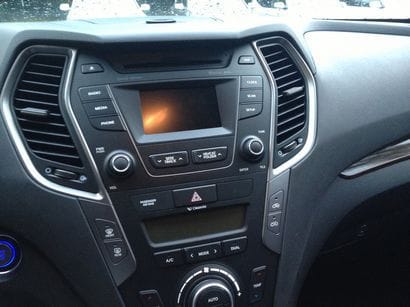
Handling, on the other hand is very good. The result of the many engineering changes can be both felt and heard on the road. Vehicle tracking is noticeably better – especially in the AWD model that features a Magna-supplied Dynamax torque-vectoring system.
Road noise is also greatly improved over the outgoing model with tire noise only really noticeable on the roughest asphalt surfaces.
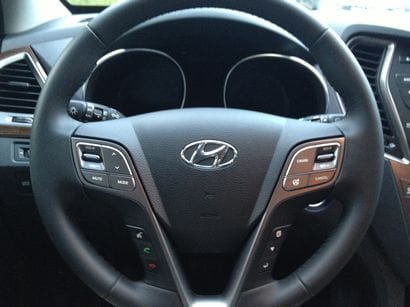
Hyundai Santa Fe Sport pricing
New car prices for the 2013 Santa Fe Sport have been set as follows:
Sport 2.4 FWD $24,450
Sport 2.4 FWD Popular $25,400
Sport 2.4 FWD Leather & Premium $28,350
Sport 2.4 FWD Technology $31,050
Sport 2.4 AWD $26,200
Sport 2.4 AWD Popular $27,150
Sport 2.4 AWD Leather & Premium $30,100
Sport 2.4 AWD Technology $32,800
Sport 2.0T FWD $27,700
Sport 2.0T FWD Leather & Premium $30,150
Sport 2.0T FWD Technology $33,050
Sport 2.0T AWD $29,450
Sport 2.0T AWD Leather & Premium $31,900
Sport 2.0T AWD Technology $34,800




